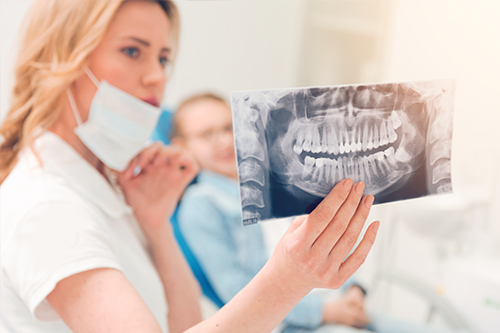
Our Office
Visit Us Online

Dental emergencies span a range of situations, from sudden, intense pain to injuries that visibly damage the teeth or soft tissues. If you or a family member experiences uncontrolled bleeding, severe swelling that affects breathing or swallowing, or a tooth that is knocked out, these are signals that prompt attention is necessary. Acting quickly can mean the difference between saving a tooth and needing a more involved replacement later on.
Not all urgent dental issues are dramatic. Persistent throbbing, a fever combined with a painful tooth, or rapidly spreading gum swelling are signs of an active infection that should be evaluated without delay. Even when symptoms seem mild at first, infections and trauma can progress quickly. Early assessment helps limit complications and often reduces the amount of treatment required.
Knowing what to do in the minutes and hours after an injury helps preserve options. Simple steps—like gently rinsing the mouth, applying a cold compress to reduce swelling, or keeping a dislodged tooth moist—can improve the chances of a favorable outcome. Our goal is to provide clear guidance so patients feel confident taking the right first steps before they arrive for care.
Our practice treats a broad spectrum of urgent concerns that affect teeth, gums, and the soft tissues of the mouth. These include severe toothaches from advanced decay, fractured or chipped teeth from accidents, and dental abscesses that cause localized pain and swelling. We also see problems related to failing restorations such as broken fillings or crowns that expose sensitive tooth structure.
Other common situations include displaced or avulsed (knocked-out) teeth, loose or uncomfortable dentures, problematic wisdom teeth that cause acute discomfort, and sudden periodontal flare-ups with significant gum swelling or bleeding. Infections of the lips, cheeks, tongue, or throat that are bacterial, viral, or fungal in origin also fall within our urgent care scope when they cause pain or compromise eating and speech.
Because oral health issues can present in many ways, the team evaluates symptoms and signs comprehensively. We look for sources of pain or infection, assess the risk to surrounding teeth and tissues, and prioritize interventions that protect overall oral health. Below are examples of conditions we commonly address:
When you arrive for an urgent visit, the initial focus is on stabilizing immediate concerns: controlling pain, stopping bleeding, and assessing any risk to airway or overall health. A concise medical and dental history helps the team identify contributing factors such as medications, allergies, or systemic conditions that affect treatment choices. Clear communication about symptoms—when they started, how they have changed, and what relieves or worsens them—guides clinical decision-making.
We use targeted diagnostics to pinpoint the problem, often starting with clinical examination and radiographs. Digital x-rays and, when appropriate, three-dimensional imaging allow us to see the tooth structure, root anatomy, and surrounding bone. This information helps determine whether a tooth can be repaired, needs root treatment, or must be removed. The exam also screens for signs that a condition has the potential to spread beyond the mouth, which can require urgent medical collaboration.
Throughout the visit we prioritize patient comfort and informed consent. Your care team will explain the findings, outline recommended next steps, and present short-term measures to relieve pain or infection. When immediate definitive treatment isn’t possible, the plan will include safe interim measures—such as temporary restorations, drainage of an abscess, or medication—to stabilize the condition until definitive care can be scheduled.
Treatment during an emergency appointment is tailored to the diagnosis and to the patient’s overall health. For painful teeth, local anesthesia and appropriate short-term medications provide rapid relief, allowing the clinician to perform conservative repairs like bonding or new restorations when feasible. If decay or trauma has compromised the tooth's nerve, root canal therapy may be recommended to preserve the natural tooth and eliminate infection.
When a tooth is beyond repair or presents a risk to adjacent structures, extraction may be the safest option. Extractions are performed with attention to comfort and healing, and we discuss tooth replacement options as part of your long-term plan. For avulsed (knocked-out) teeth, prompt replantation—when possible—offers the best chance of success, so timing and proper handling are critical.
In cases of abscess or spreading infection, drainage and infection control are priorities. We may prescribe appropriate antimicrobial therapy and provide instructions to reduce swelling and promote recovery. For complex injuries or when airway or systemic risks are present, the team coordinates with medical providers to ensure comprehensive care and safe outcomes.
After urgent treatment, recovery focuses on pain management, infection control, and protecting the treated area while healing occurs. Patients receive clear aftercare instructions—covering oral hygiene, diet modifications, activity limitations, and signs that warrant a follow-up visit. Proper self-care and adherence to prescribed medications reduce the risk of complications and support timely recovery.
Restoration of full function and esthetics is often the next phase. Options to replace missing teeth or rebuild damaged ones include dental implants, fixed bridges, and partial or complete dentures. The right solution depends on your oral health, bone support, and personal goals. We discuss the advantages and clinically appropriate choices so you can make an informed decision about long-term care.
Prevention is an essential part of emergency care. Identifying the underlying causes—such as untreated decay, grinding, or periodontal disease—helps us develop a plan to reduce future risk. Regular dental visits, timely treatment of developing problems, and patient education about protective measures can significantly lower the likelihood of repeat emergencies.
At Frankford Dental Group, our emergency care approach combines rapid assessment, evidence-based interventions, and clear guidance to help you return to comfort and function as quickly as possible. If you are experiencing a dental emergency or have urgent oral health concerns, please contact us for more information and to arrange prompt care.

Pain is your body's way of signaling that something is not quite right and though there are many reasons for oral pain, one of the most common complaints and reasons for seeking urgent dental care is a toothache. Whether you simply need a dental filling, a crown, or require a root canal procedure to save your tooth, we'll alleviate your discomfort and restore the look and function of the involved tooth.

Dental trauma can result in a defect as minor as a small chip in tooth enamel to a more extensive and painful crack or fracture. With sufficient force, a tooth can even be displaced or completely knocked out of its socket. With prompt emergency care, many injured teeth can be restored and saved.

The last teeth in your mouth to develop, wisdom teeth often do not have enough room to fully erupt or may be positioned in the wrong direction. These issues can affect your dental health as well as overall well-being. Our office provides skilled care to address the complications caused by problematic wisdom teeth.

A broken or lost dental prosthesis or restoration can cause embarrassing gaps in your smile as well as compromise your ability to eat and speak with ease. If you've lost or broken a dental filling, denture, crown, or other dental appliance, you can rely on our office to perform a prompt repair or provide a durable and cosmetically pleasing replacement as quickly as possible.
At the office of Frankford Dental Group, emergency appointments are always available. Of course, in addition to providing top treatment for dental emergencies, we also welcome patients searching for high quality and affordable care. We offer a complete range of the latest and best cosmetic and dental services for every member of your family.
If you are suffering from a toothache or have sustained a dental injury, it is important to visit the dentist as soon as possible before more serious complications arise. Whether your dental emergency is painful, if it affects the appearance of your smile, or if you suspect that an infection is present, our office will make every effort to see you as promptly as possible for care.
At the office of Frankford Dental Group, we treat your dental emergency as our top priority. Our caring team will respond to your emergency call right away, making sure you get the gentle, state-of-the-art care you need without delay.
As your trusted emergency dentist in Lubbock, we provide the highest quality of care to mitigate the stress, anxiety, and discomfort of dental problems. Our dedicated team will help you start feeling better as soon as we receive your emergency call.
At the office of Frankford Dental Group, we provide skilled and experienced care to effectively resolve a broad range of dental emergencies, restoring a patient's oral health while protecting their overall wellbeing.
However, even so, specific dental emergencies pose significant threats to one's health. These situations require immediate, emergency room care. Serious and potentially life-threatening dental emergencies include significant oral and facial trauma such as jaw fractures, deep wounds or lacerations to the face and mouth, an abscess or infection that causes widespread facial or submandibular swelling, or affects breathing and swallowing.
At the office of Frankford Dental Group, we provide prompt, skilled, and experienced care to address dental emergencies. We understand that finances are always a concern and do our best to provide options in care that are both affordable and respect your budget.
Once we've had the opportunity to examine your smile, we can give you a clear picture of any existing dental issues, along with a quote for what the cost of treatment will be. The cost of care all depends upon the extent and complexity of issues affecting the health or appearance of your smile and the types of procedures that are required.
To help alleviate any additional stress or delay, you can count on our staff to work with you to optimize coverage for your dental care and to minimize your out-of-pocket expenses. For patients without insurance, we strive to make things easier as well! We invite you to visit our financial information page or speak to an expert in our business office.
Dental emergencies are often painful and debilitating experiences. For this reason it's important to have an emergency dentist in Lubbock, who welcomes patients with urgent dental needs while providing the prompt care required to restore oral health.
Here are just some of the reasons why so many patients choose our office for emergency dental care and to meet their family's dental needs:
We're dedicated to helping patients enjoy good oral health and beautiful smiles. We look forward to helping you keep your smile in tip-top condition. You can rest assured that our highly skilled office team will provide you the highest quality of state-of-the-art dental care and have you smiling again in no time!
To make an appointment or for more information on our office and the many state-of-the-art services we provide, give us a call today.
Dental emergencies include sudden, severe pain, uncontrolled bleeding, traumatic injuries and symptoms that affect breathing or swallowing. If you experience uncontrolled bleeding, severe swelling that affects breathing or swallowing, or a tooth that has been knocked out, seek immediate care. Acting promptly improves the chance of saving the tooth and limits the risk of infection spreading.
If you are in Lubbock and need urgent attention, contact Frankford Dental Group at (806) 587-5070 to arrange a same-day evaluation or get specific first-aid instructions. For signs of airway compromise or severe systemic illness, go to the nearest emergency department without delay. Early assessment often reduces the complexity and duration of definitive treatment.
Locate the tooth and handle it by the crown rather than the root to avoid damaging the ligament fibers. Gently rinse the tooth with clean water if it is dirty, and never scrub or use soap; if possible reinsert it into the socket and hold it in place. If reinsertion is not possible, keep the tooth moist by placing it in milk, saline, or the patient’s saliva.
Time is critical for successful replantation, so seek emergency dental care as soon as possible, ideally within an hour. Bring the tooth with you and avoid touching the root surface while transporting it. The dental team will assess the socket, stabilize the tooth and determine whether root canal treatment or further stabilization is required.
Begin by rinsing the mouth with warm saltwater to reduce debris and gently floss to remove trapped food that may be causing pressure. Apply a cold compress to the cheek to reduce swelling and use over-the-counter pain relievers according to package directions to control pain. Avoid placing aspirin or other medications directly on the tooth or gums, as this can cause tissue damage.
Limit chewing on the affected side and avoid very hot or cold foods that may worsen sensitivity. These measures are temporary and you should seek professional evaluation if pain persists, intensifies or is accompanied by fever or swelling. Prompt dental care identifies the cause and prevents progression to more serious infection.
Warning signs of a dental infection include persistent throbbing pain, facial or gum swelling that increases over hours, fever, and a bad taste or odor in the mouth. Difficulty opening the mouth, swallowing or breathing are red flags that require immediate attention. Localized swelling that is warm or rapidly enlarging may indicate an abscess that needs urgent treatment.
If you notice these symptoms, contact a dental professional promptly so they can evaluate the extent of infection and the need for antibiotics or drainage. Imaging such as digital x-rays or three-dimensional scans helps identify the source and plan treatment. Early intervention reduces the risk of the infection spreading beyond the oral tissues.
Treatment of a dental abscess focuses on controlling infection, relieving pain and addressing the source of the problem. The clinician may perform drainage of the abscess, prescribe appropriate antimicrobial therapy when indicated, and provide analgesics and home-care instructions to reduce swelling. Diagnostic imaging and tests guide whether the tooth can be saved or requires removal.
When the infected tooth can be preserved, root canal therapy often removes the infected tissue and restores the tooth’s function. If the tooth is not restorable or presents a risk to adjacent structures, extraction may be recommended followed by discussion of replacement options. Follow-up care and monitoring are important to confirm resolution of the infection and healing.
Whether a fractured tooth can be saved depends on the fracture’s location, depth and involvement of the tooth’s root or nerve. Minor chips and cracks that affect only the enamel can often be repaired with bonding or a crown, while deeper fractures that expose the pulp may require root canal therapy. Vertical root fractures have a poorer prognosis and sometimes necessitate extraction.
The dentist will use clinical tests and imaging to determine the extent of the damage and the best approach to restore form and function. Immediate stabilization, such as smoothing sharp edges or placing a temporary crown, can protect the tooth and reduce pain until definitive care. Long-term treatment plans consider esthetics, chewing forces and the tooth’s structural integrity.
If a filling or crown breaks and exposes sensitive tooth structure, gently rinse the area and avoid chewing on that side to prevent further damage. You can cover sharp or exposed edges with a small piece of sugarless gum or dental wax as a short-term measure to reduce irritation. Keep the area clean with gentle brushing and warm saltwater rinses to lower the risk of infection.
A prompt dental evaluation is important to assess underlying decay or fracture and to determine whether repair or replacement is needed. The dentist may place a temporary restoration to protect the tooth and alleviate sensitivity until definitive treatment can be completed. Addressing the issue early helps prevent progression to pulp involvement or abscess formation.
For bites, lacerations or other soft-tissue injuries inside the mouth, begin by rinsing with clean water and applying gentle pressure with sterile gauze to control bleeding. A cold compress applied to the outside of the face can reduce swelling and discomfort for the first 24 hours. If bleeding does not stop, the wound is deep, or there are signs of foreign material embedded in the tissue, seek urgent evaluation.
Treatment may include sutures to approximate edges, topical care to promote healing, and instruction on oral hygiene to prevent infection. In some cases antibiotics or referral to a medical facility are necessary, particularly for severe or contaminated injuries. The dental team will provide clear aftercare guidance and monitor healing during follow-up visits.
Children can and should be seen for dental emergencies, and treatment is adapted to their age and level of cooperation to make the visit as safe and stress-free as possible. The practice offers pediatric-focused care, including in-office sedation and general anesthesia provided by a Board-Certified Dental Anesthesiologist when multiple procedures or extensive treatment are required. Prioritizing comfort helps ensure effective management of pain, infection and traumatic injuries.
Parents should bring any avulsed teeth, relevant medical information and a calm explanation of how the injury occurred to aid assessment. The clinician will explain options in simple terms, obtain parental consent for urgent procedures and coordinate follow-up to restore function and monitor healing. Early presentation for pediatric injuries improves the chances of saving teeth and minimizes long-term complications.
During an emergency dental visit the initial focus is stabilization: controlling pain, stopping bleeding and assessing risks to the airway or overall health. The dental team will take a focused medical and dental history, perform a clinical examination and use targeted imaging such as digital x-rays or three-dimensional scans when needed. This information guides whether immediate definitive treatment, temporary stabilization or referral is appropriate.
At Frankford Dental Group you can expect clear explanations of findings, a treatment plan tailored to your needs and instructions for home care and follow-up. Short-term measures may include temporary restorations, drainage of an abscess, medication to control infection and scheduling of definitive care such as root canal therapy or restorative work. The goal is to restore comfort and function while minimizing future risk.
Available after hours by appointment.
